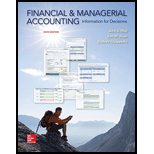
1.
1.
Explanation of Solution
Issue of bonds at discount on January 1, 2015
| Date | Account Title and Explanation | Post. Ref. |
Debit ($) |
Credit ($) |
|---|---|---|---|---|
| January 1 | Cash | 4,859,980 | ||
| Premium on bonds payable | 895,980 | |||
| Bonds payable | 4,000,000 | |||
| (To record the sold bonds at premium) |
Table (1)
• Cash account is the assets account. Since the cash is received, the value of assets is increased. So, debit the credit the cash account.
• Premium on bonds payable account is the liabilities account. Here, at the time of issue of the bonds premium has been given which increase the liabilities of the company. So, credit the premium on bonds payable account.
• Bonds payable account is the liabilities account. Bonds has been sold, which increases the liabilities of the company. So, credit the bonds payable account.
2.
Cash payment, straight line amortization and bonds interest expense.
2.
Explanation of Solution
(a)
Given,
Amount of bond is $4,000,000.
Rate of interest is 6%.
Time period is 0.5.
Formula to calculate the cash at the time of issue of bond:
Substitute $4,000,000 for the bond value, 6% for the rate on interest and 0.5 for time period,
Hence, cash payment account is $120,000.
(b)
Given,
Par value of bond is $4,000,000.
Issued
Number of semiannual period is 30.
Formula to calculate the straight line discount amortization:
Substitute $895,980 for the discount on bond and 30 for number of semiannual period,
Hence, amortization is $29,866.
Working note:
Calculation of discount on bond:
(c)
Given,
Cash payment is $120,000.
Amortization expense is $29,866.
Formula to calculate bonds interest payment expense:
Substitute $120,000 for cash payment and $29,866 for amortization,
Hence, bonds interest expense is $90,134.
3.
Total amount of interest payable on bond.
3.
Explanation of Solution
| Particulars | Amounts ($) |
|---|---|
| 30 Regular outlays of $120,000 | 3,600,000 |
| Par value at maturity | 4,000,000 |
| Net repaid | 7,600,000 |
| Less: Money borrowed | 4,895,980 |
| Bond interest expense | 2,704,020 |
Table (2)
Hence, total bond interest expense is $2,704,202.
4.
First two year of an amortization table.
4.
Explanation of Solution
| End of semiannual period | Unamortized Discount ($) |
Carrying value ($) |
|---|---|---|
| January 1, 2017 | 895,980 | 4,895,980 |
| June 30, 2017 | 866,114 | 4,866,114 |
| December 31, 2017 | 836,248 | 4,836,248 |
| June 30, 2018 | 806,382 | 4,806,382 |
| December 31, 2018 | 776,516 | 4,775,516 |
Table (3)
5.
Journal entry to record the first two interest payment.
5.
Explanation of Solution
Payment of interest on June 30, 2015
| Date | Account Title and Explanation | Post. Ref. |
Debit ($) |
Credit ($) |
|---|---|---|---|---|
| June 30 | Bonds interest expense | 90,134 | ||
| Premium on bonds payable | 29,866 | |||
| Cash | 120,000 | |||
| (To record the paid semiannual interest and record amortization) |
Table (4)
• Bonds interest account is an expense account. Interest has been paid by the company which increases the liabilities of the company. So, debit the bonds interest expense account.
• Premium on bonds payable account is the liabilities account. Here, at the time of issue of the bonds premium has been given which increases the liabilities of company. Now premium on bonds payable has been paid which decrease the liability. So, debit the premium on bonds payable account.
• Cash is an asset account. Since the cash is paid, the value of assets is decreased. So, credit the Cash account.
Payment of interest on December 31, 2015
| Date | Account Title and Explanation | Post. Ref. |
Debit ($) |
Credit ($) |
|---|---|---|---|---|
| Dec 31 | Bonds interest expense | 90,134 | ||
| Premium on bonds payable | 29,866 | |||
| Cash | 120,000 | |||
| (To record the paid semiannual interest and record amortization) |
Table (5)
• Bonds interest account is an expense account. Interest has been paid by the company which increases the liabilities of the company. So, debit the bonds interest expense account.
• Premium on bonds payable account is the liabilities account. Here, at the time of issue of the bonds premium has been given which increases the liabilities of company. Now premium on bonds payable has been paid which decrease the liability. So, debit the premium on bonds payable account.
• Cash is an asset account. Since the cash is paid, the value of assets is decreased. So, credit the cash account.
Want to see more full solutions like this?
Chapter 10 Solutions
Financial and Managerial Accounting: Information for Decisions

 AccountingAccountingISBN:9781337272094Author:WARREN, Carl S., Reeve, James M., Duchac, Jonathan E.Publisher:Cengage Learning,
AccountingAccountingISBN:9781337272094Author:WARREN, Carl S., Reeve, James M., Duchac, Jonathan E.Publisher:Cengage Learning, Accounting Information SystemsAccountingISBN:9781337619202Author:Hall, James A.Publisher:Cengage Learning,
Accounting Information SystemsAccountingISBN:9781337619202Author:Hall, James A.Publisher:Cengage Learning, Horngren's Cost Accounting: A Managerial Emphasis...AccountingISBN:9780134475585Author:Srikant M. Datar, Madhav V. RajanPublisher:PEARSON
Horngren's Cost Accounting: A Managerial Emphasis...AccountingISBN:9780134475585Author:Srikant M. Datar, Madhav V. RajanPublisher:PEARSON Intermediate AccountingAccountingISBN:9781259722660Author:J. David Spiceland, Mark W. Nelson, Wayne M ThomasPublisher:McGraw-Hill Education
Intermediate AccountingAccountingISBN:9781259722660Author:J. David Spiceland, Mark W. Nelson, Wayne M ThomasPublisher:McGraw-Hill Education Financial and Managerial AccountingAccountingISBN:9781259726705Author:John J Wild, Ken W. Shaw, Barbara Chiappetta Fundamental Accounting PrinciplesPublisher:McGraw-Hill Education
Financial and Managerial AccountingAccountingISBN:9781259726705Author:John J Wild, Ken W. Shaw, Barbara Chiappetta Fundamental Accounting PrinciplesPublisher:McGraw-Hill Education





